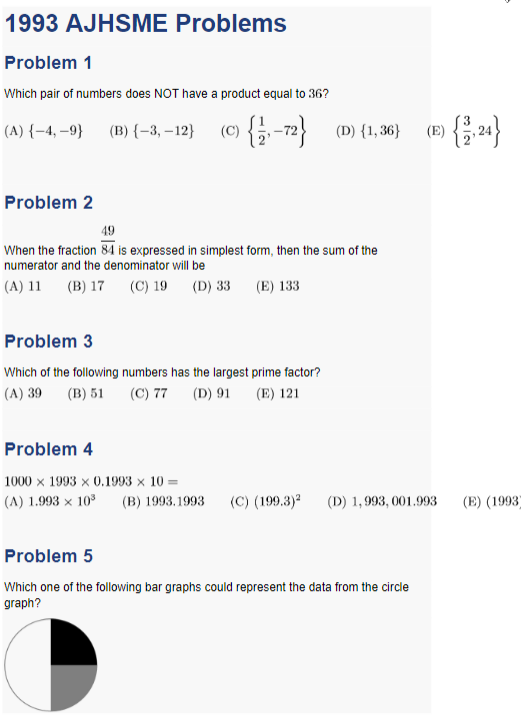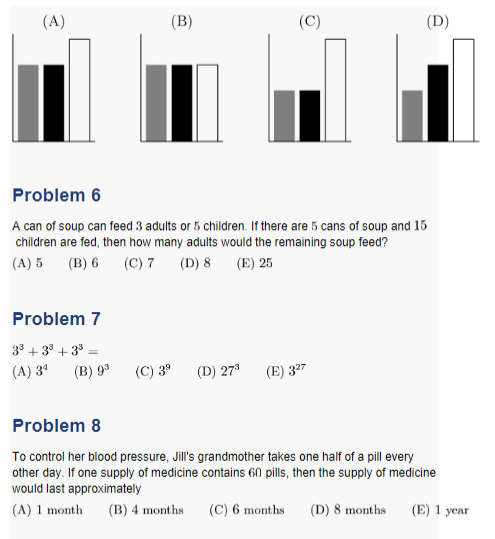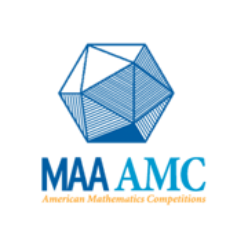1993年AJHSME 真题:
Problem 1
Which pair of numbers does NOT have a product equal to ![]() ?
?
![]()
Problem 2
When the fraction ![]() is expressed in simplest form, then the sum of the numerator and the denominator will be
is expressed in simplest form, then the sum of the numerator and the denominator will be
![]()
Problem 3
Which of the following numbers has the largest prime factor?
![]()
Problem 4
![]()
![]()
Problem 5
Which one of the following bar graphs could represent the data from the circle graph?
![[asy] unitsize(36); draw(circle((0,0),1),gray); fill((0,0)--arc((0,0),(0,-1),(1,0))--cycle,gray); fill((0,0)--arc((0,0),(1,0),(0,1))--cycle,black); [/asy]](https://latex.artofproblemsolving.com/b/4/8/b480e466979a91180c302aa9c41642901ab83158.png)
![[asy] unitsize(4); fill((1,0)--(1,15)--(5,15)--(5,0)--cycle,gray); fill((6,0)--(6,15)--(10,15)--(10,0)--cycle,black); draw((11,0)--(11,20)--(15,20)--(15,0)); fill((26,0)--(26,15)--(30,15)--(30,0)--cycle,gray); fill((31,0)--(31,15)--(35,15)--(35,0)--cycle,black); draw((36,0)--(36,15)--(40,15)--(40,0)); fill((51,0)--(51,10)--(55,10)--(55,0)--cycle,gray); fill((56,0)--(56,10)--(60,10)--(60,0)--cycle,black); draw((61,0)--(61,20)--(65,20)--(65,0)); fill((76,0)--(76,10)--(80,10)--(80,0)--cycle,gray); fill((81,0)--(81,15)--(85,15)--(85,0)--cycle,black); draw((86,0)--(86,20)--(90,20)--(90,0)); fill((101,0)--(101,15)--(105,15)--(105,0)--cycle,gray); fill((106,0)--(106,10)--(110,10)--(110,0)--cycle,black); draw((111,0)--(111,20)--(115,20)--(115,0)); for(int a = 0; a < 5; ++a) { draw((25*a,21)--(25*a,0)--(25*a+16,0)); } label("(A)",(8,21),N); label("(B)",(33,21),N); label("(C)",(58,21),N); label("(D)",(83,21),N); label("(E)",(108,21),N); [/asy]](https://latex.artofproblemsolving.com/6/a/6/6a6150208e92b19052587795c996686bcd1a5a50.png)
Problem 6
A can of soup can feed ![]() adults or
adults or ![]() children. If there are
children. If there are ![]() cans of soup and
cans of soup and ![]() children are fed, then how many adults would the remaining soup feed?
children are fed, then how many adults would the remaining soup feed?
![]()
Problem 7
![]()
![]()
以下是我们为您整理的全英版pdf真题,扫码即可免费领取完整版:



扫码免费预约领取更多AMC历年真题+答案
预约最新真题讲座、课程详情可添加下方顾问老师咨询

